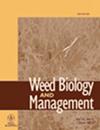Distributions of exotic herbaceous species along a roadside on Chichijima, the Ogasawara Islands, and their relationship with human disturbance
IF 1.5
4区 农林科学
Q3 AGRONOMY
引用次数: 0
Abstract
Oceanic islands are a major tourist destination, and the invasion of exotic plants on oceanic islands is a serious problem. To discuss how exotic herbaceous plant invasion is driven by human disturbance on an oceanic island, we assessed the distribution patterns of exotic herbaceous species along a metropolitan road, including parking lots, on the island of Chichijima in the Ogasawara Islands of Japan in the North Pacific Ocean. We observed 16 exotic herbaceous species representing seven families, and all the species have also been recorded in surveys 25 years ago. Species richness (number of species per plot) ranged from 0 to 9 with an average of 2.49. Distance from a parking lot was significantly negatively related to the distribution patterns of seven species and positively related to three species, pointing to parking lots being critical nodes along the dispersal pathways of exotic herbaceous species in Chichijima. Although roads are well known to play an important role as corridors for the invasion and seed dispersal of exotic plants, our results suggest that it would also be important to consider the location of parking lots to understand the distribution of exotic herbaceous species in road networks. We suggest that intensive weed management near parking lots and car wash protocols on Chichijima may be effective in halting exotic species spread.小笠原群岛七岛路边外来草本物种的分布及其与人类干扰的关系
海洋岛屿是主要的旅游目的地,外来植物入侵海洋岛屿是一个严重的问题。为了探讨外来草本植物入侵海洋岛屿是如何受人类干扰驱动的,我们评估了北太平洋日本小笠原群岛七岛的一条城市道路(包括停车场)沿线外来草本植物物种的分布模式。我们观察到了 16 种外来草本植物,分别代表 7 个科,所有物种在 25 年前的调查中都有记录。物种丰富度(每块地的物种数量)从 0 到 9 不等,平均为 2.49。与停车场的距离与 7 个物种的分布模式呈显著负相关,与 3 个物种呈显著正相关。众所周知,道路是外来植物入侵和种子传播的重要通道,但我们的研究结果表明,要了解外来草本物种在道路网络中的分布情况,还必须考虑停车场的位置。我们建议,在七岛对停车场附近的杂草进行强化管理并制定洗车规程,可能会有效阻止外来物种的传播。
本文章由计算机程序翻译,如有差异,请以英文原文为准。
求助全文
约1分钟内获得全文
求助全文
来源期刊

Weed Biology and Management
农林科学-农艺学
CiteScore
2.70
自引率
0.00%
发文量
13
审稿时长
>36 weeks
期刊介绍:
Weed Biology and Management is an international journal, published four times per year. The journal accepts contributions in the form of original research and review articles in all aspects of weed science. Contributions from weed scientists in the Asia–Pacific region are particularly welcomed.
The content of the contributions may relate to weed taxonomy, ecology and physiology, weed management and control methodologies, herbicide behaviors in plants, soils and environment, utilization of weeds and other aspects of weed science. All contributions must be of sufficient quality to extend our knowledge in weed science.
 求助内容:
求助内容: 应助结果提醒方式:
应助结果提醒方式:


